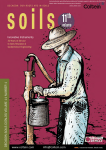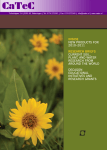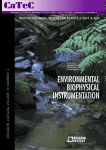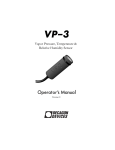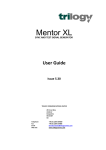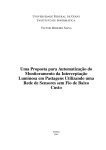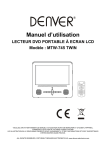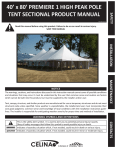Download Environmental Instrumentation
Transcript
Environmental Instrumentation New Instrumentation 1, 2 Soil Moisture Networks: GS3 Sensor, DS-2 Sonic Anemometer, ES-2 EC and Temp. Hydrology: VSA, CTD Sensor and WP4C. Canopy: SRS (PRI/NDVI). Canopy 3 Leaf Porometer 3 LP-80 Ceptometer: Measure PAR & LAI 5 Leaf Wetness Sensor: Built-to-order 7 Soil Moisture 9 Decagon Soil Moisture Systems Introduction 9 Soil Moisture Sensors GS3, EC-5, 10HS, 5TE, 5TM, MPS-2. 11 Environmental Sensors & ProCheck Cup Anemometer, PYR/PAR Photon Flux Sensor, RT-1, Temp RH, ECRN-50/100. 12 Em50 Series Data Loggers 13 DataTrac 3: Complete Soil Moisture Analysis 15 Em50G Webviewer: Data On The Go 16 Irrigation Management 17 Water Balance 18 Water Potential Soils 19 WP4C Water Potential Data 19 Mini Disk Infiltrometer: Soil Hydraulic Conductivity 20 VSA: Vapour Sorption Analyser For Soil Isotherms 21 Hydrology 23 Drain Gauge G2/G3 23 CTD Sensor: Continuously Monitor Groundwater 25 Thermal KD2 Pro: Model Heat Movement KS-1, SH-1, RK-1, TR-1. 27 27 New Instrumentation CTD Sensor SRS (PRI/NDVI) Continuously monitor groundwater and surface water level changes along with electrical conductivity and temperature. The SRS is designed for long-term autonomous measurement Water depth, temperature, and electrical conductivity. Temperature Range: -40 to +50°C.* Accuracy: ±1°C. Resolution: 0.1°C. Water Depth Range: 0 to 3.5 m. Accuracy: ±0.2 % of span at 20°C. Data Logger Compatibility Resolution: 1 mm. Em50/Em50G. Call for compatibility of Data Loggers. Electrical Conductivity Range: 0 to 120 dS/m (mS/cm). *Operating temperature 0 to 50˚C Accuracy: ±0.01 dS/m or ±10%. (Pressure transducer cannot be Resolution: 0.001 dS/m. allowed to freeze while submerged). For more details see page 25. Monitor the Normalised Difference Vegetation Index or the Photochemical Reflectance Index. design goals is to reduce the cost of collecting high quality spatially distributed data in quantity over an entire growing season. Operating Temperature Range: 40 to 50°C. Calibration: NIST traceable calibration Accuracy: 10% or better for spectral known spectral radiance (W m -2 nm -1 ) or irradiance and radiance values. irradiance (W m -2 nm -1 sr --1 ). Measurement Time: < 300 ms. Foreoptics: (1) Cosine correcting Teflon diffuser, hemispherical field of view (2) Field Dimensions: 43 x 40 x 27mm. Power: 3.6 to 15 VDC, 4 mA (reading, stop, 20° field of view. 300 ms), 30µA (quiescent). PRI Wavebands: 531±3 and 570±3 nm Connector Type: 3.5 mm (stereo) plug peak wavelengths, with 10 nm full width half or stripped and tinned lead wires. maximum (FWHM) band widths Communication: SDI-12 digital sensor. NDVI Wavebands: 630±5 and 800±5 nm peak wavelengths, with 50 nm and 40 nm full width half maximum (FWHM) band widths. Cable Length: 5 m standard, custom cable length available upon request. Vapour Sorption Analyser Automated soil water characterise curves. GS3 Sensor New rugged design. Stainless steel needles and epoxy casing make the GS3 the optimal sensor for long term soil water studies. Volumetric Water Content Range: 0–100%. Accuracy: ±3% in typical soils. Resolution: 0.002 m3/m3 Temperature Range: -40–80°C. Accuracy: ±1°C. Resolution: 0.1°C. For more details see page 11. Electrical Conductivity Range: 0 to 23 dS/m (bulk). Accuracy: ±1% Resolution: 0.001 dS/m Generates up to 200 data points (water potential vs. water content) for both adsorption and desorption within 24-48 hours. The VSA works in the dry (-10 to -475 MPa) range. Create automated soil-water characteristic curves and generate all the correlations with clay activity, surface area, and swelling potential. Hold humidity constant and look at the way soil takes up water into its crystal structure (2:1 clays) and monitor water content change over time. Range: -10 to -475 MPa. Accuracy: ±1 MPa or ±1%. Temperature operating range: 15 to 60°C. Size: W 25.4 x L 38.1 x H 30.5 cm (10x15x12 in.) Weight: 19 kg. For more details see page 21. 1 1 Watch a video on innovative ways the VSA is being used in soils applications. learn.decagon.com/VSA New DS-2 Wind speed and direction. The DS-2 is a two dimensional sonic anemometer that measures wind speed and wind direction. Wind speed and wind direction are fundamental measurements necessary for a wide range of agricultural, forestry and micro-meteorological research and management applications. The DS-2 has no moving parts, does not require maintenance or recalibration and is capable of making high accuracy measurements, even at low wind speeds. DS-2 Specifications Wind speed range: 0 to 30 m/s. Wind speed resolution: 0.01 m/s. Wind speed accuracy: 0.30 m/s or < 3%, which ever is greater. Wind direction range: 0 to 359°. Wind direction resolution: 1°. Wind direction accuracy: ± 3°. Maximum sampling speed: 1 Hz. Operating temperature range: 40 to +50°C. Physical dimensions diameter: 100 mm, Overall height: 155 mm. Cable length: 5 m standard, custom length available upon request. Outputs: (3) Wind speed, gust speed, wind direction or vector. WP4C Lab water potential measurements. The WP4C measures water potential by determining the relative humidity of the air above a sample in a closed chamber (an AOAC-approved method, conforms to ASTM 6836). New features ES-2 Temperature and electrical conductivity. The ES-2 allows you to obtain additional EC measurements for salt balance studies and nutrient monitoring. Monitor EC in pipes, tanks or wells. ES-2 Specifications Electrical Conductivity Range: 0 to 120 dS/m (mS/cm). Accuracy: ±0.01 dS/m or ±10% (which ever is greater). Resolution: 0.001 dS/m. Temperature Range: -40 to +50°C. Accuracy: ±1°C. Resolution: 0.1°C. •Precise Mode -Verifies full equilibrium before displaying a final reading. •Speedy Equilibration -New hydrophobic teflon impregnated nickel alloy sample chamber coating reduces equilibration time. •Finely-Tuned Adjustments -New algorithms allow precision calibration and ±0.05 MPa (or better) accuracy. •Better range and accuracy -Resolves temperatures to a thousandth of a degree to push the functional range to -0.1 MPa. WP4C Specifications Operating environment: 5 to 43°C (41 to 110°F). Temperature control: 15 to 40°C ±0.2°C. Sensors: 1. Infrared temperature 2. Chilled-mirror dew point. Range: 0 to -300 MPa. Accuracy: ±0.05 MPa from 0 to -5 MPa, ±1% from -5 to -300 MPa. Read time: Typically 5 to 10 minutes. Interface cable: Serial cable (included). For more details see page 19. Data communications: RS232 compatible, 8-bit ASCII code, 9600 baud, no parity, 1 stop bit. Weight: 3.2 kg (5.2 kg shipping weight). Universal power: 110-220V AC, 50/60 Hz. Sample dish* capacity: 7 ml recommended (15ml full). Calibration standard: 0.5 molal KCl (-2.22 MPa). *25 plastic cups and 10 stainless steel cups included. Watch R&D scientist Dr. Doug Cobos discuss the advancements made with the new WP4C. learn.decagon.com/WP4C 2 Porometer Research for Everyone High quality data without fans, tubes, or pumps. Steady State design makes accurate stomatal conductance measurements affordable and practical for everyday research. Use stomatal conductance to evaluate plant water use, quantify water stress, and compare physiological response of different varieties. Applications • • • • Water Stress Measurements. Variety Testing & Comparison. Fundamental Research on Stomatal Function. Teaching and Student Labs. Benefits • • • Automatic sampling mode eliminates user subjectivity. Accurate Steady-State measurement. No tubes, pumps, or fans. Leaf Porometer Specifications Conductance range: 0 to 1000 mmol m -2 s -1 . Accuracy: ±10%. Operating environment: 5 to 40ºC, 10 to 90% RH. Units: mmol m -2 s -1, m 2 s mol -1, s/m. Measurement: Aperture measurement 6.3 mm. Sensor head cable length: 1.2 m (4 ft.). Measurement time in auto mode: 30s. Power: 4 AA alkaline cells. Data storage: 4095 Measurements in flash memory learn.decagon.com/porometer Watch a 3 minute video to see methods to measure stomatal conductance. 3 CANOPY Mathematics of the Steady State Porometer FRONT: INSIDE LOOK Decagon’s Steady State Porometer measures stomatal conductance using a sensor head measures the vapour concentration at two different locations in the diffusion path. Top Leaf R vs C VL C V1 concentration measurements and the known conductance of the diffusion path using the following equation: R1 R2 C V2 Humidity Sensors Agitation Bead Where C vL is the vapour concentration at the leaf, C v1 and C v2 are the concentrations at the two sensor locations, R vS is the stomatal resistance, R 1 is the resistance between 2 is the resistance between the two sensors. If the temperatures of the two sensors are the same, vapour concentration can be replaced with relative humidity, giving Conductance is the reciprocal of resistance, so new 4 Photosynthetically Active Radiation & Leaf Area Index. Canopy Measurements PAR/LAI Measure PAR and LAI with the AccuPar LP-80 Ceptometer. Use PAR Data to estimate biomass production without destroying the crop (see details at right). Measure photosynthetically active radiation (PAR) and get leaf area index (LAI) values simultaneously in real time. Store approximately 9000 data points manually by pressing a button or automatically in unattended sampling mode. learn.decagon.com/LP80 Watch a two minute video on measuring PAR and LAI with the AccuPar LP-80. AccuPAR LP-80 Specifications Operating environment: 0 to 5°C, 0 to 100% relative humidity. Probe length: 86.5 cm. Number of sensors: 80. Overall length: 102 cm (40.25 in). Microcontroller dimensions: 15.8 x 9.5 x 3.3 cm (6.2 x 3.75 x 1.3 in). PAR range: 0 to >2,500 µmol m -2 s -1 . Resolution: 1 µmol m -2 s -1 . Minimum spatial resolution: 1 cm. Data storage capacity: 1MB RAM, 9000 readings. Unattended logging interval: User selectable, between 1 and 60 minutes. Instrument weight: 1.22 kg (2.7 lbs). Data retrieval: Direct via RS-232 cable. Power: 4 AA Alkaline cells. External PAR sensor connector: Locking 3-pin circular connector. Extension cable option: 7.6 m (25 ft). Included Accessories 5 • External PAR sensor. 2 metre cable with connector for direct connection to the ceptometer’s external port. Calibrated to provide an output of about 0.1 mV per µmol m -2 s -1 (calibration label provided). • RS-232 cable. For interfacing between your computer and the AccuPAR. • Carrying case. Polyethylene hardened case with custom foam cutouts allow the instrument and its accessories to be safely stored inside. 3.6 kg, 11.8 x 24 x 109 cm. CANOPY 25 20 15 Potatoes Barley 10 Apples 5 0 0.0 0.50 1.0 1.5 86.5 cm TOTAL DRY MATTER (Mg/ha) Sugar Beets INTERCEPTED SOLAR RADIATION (GJ/m2) Nondestructive Biomass Prediction The conversion of light energy and atmospheric carbon dioxide to plant biomass is fundamentally important to both agricultural and natural ecosystems. The detailed biophysical and biochemical processes by which this occurs are well understood. At a less detailed level, though, it is often useful to have a simple model that can be used to understand and analyse parts of an ecosystem. Such a model has been provided by Monteith (1977). He observed that when biomass accumulation by a plant community is plotted as a function of the accumulated solar radiation intercepted by the community, the result is a straight line. Figure 1 shows Monteith’s results. learn.decagon.com/assimilation For more information view the free virtual seminar “Model Carbon Assimilation By Plants.” 6 Built-to-order Leaf Wetness Sensor Detect leaf wetness duration with a sensitive, calibrated, standardised sensor. Many diseases affect plants only when moisture is present on the leaf surface. The Dielectric Leaf Wetness Sensor determines the presence and duration of wetness on a leaf’s surface, enabling both researchers and growers to forecast disease and protect plant canopies. The Decagon Leaf Wetness Sensor approximates the thermal mass and radiative properties of leaves to closely mimic the wetness state of a real leaf. Because the sensor does not take resistance based measurements, it requires no painting or user calibration, and has the ability to detect ice formation as well. Applications • • Disease forecasting and modelling. Ecological and agricultural research. Specifications Measurement time: 10 ms. Power: 2.5 VDC @ 10 mA to 5 VDC @ 7 mA. Output: 250 to 1500 mV. Operating environment: -20 to 60°C. Expected lifetime: 2+ years continuous use. Probe dimensions: 1.2 x 5.8 x 0.075 cm (4.4 x 2.3 x 0.029 in) Cable length: 5 m standard, custom length available. Connector type: 3.5 mm plug. Data logger compatibility: (not exclusive) – Decagon Em50, Em50G, Campbell Scientific CR10, 10X, 21X, 23X, 1000, 3000 and 3500. 7 CANOPY High resolution sensor distinguishes between frost, dew and rain. PROBE OUTPUT (RAW COUNTS) 1200 1100 1000 900 800 700 Dew Rainfall 600 500 Frost Frost 400 Wetness Threshold 300 72 72.5 73 73.5 74 74.5 75 TIME (DAYS) Because ice has a much lower dielectric content than that of liquid, the sensor output from frost will be much lower than that from a similar amount of rain or dew When read with the Em50 data logger, the LWS outputs 445 raw counts when dry. When the sensor is totally wet, as in heavy rain, the signal can range up to around 1400 counts. Varying amounts of water on the surface will cause sensor output proportional to the amount of water on the sensor’s surface. learn.decagon.com/LWS Watch a 4 minute video on the unique measuring capabilities of the Leaf Wetness Sensor. 8 Soil Moisture Systems Big Networks for Big Science. Available Sensors Data Loggers Software See the new rugged soil moisture sensor line plus standard soil moisture probes and a range of above-ground sensors. Hassle-free access to your data—set up the logger and start logging in less than 30 minutes. DataTrac 3 provides you with an almost real-time graphical picture of your data. Details on page 13 Details on page 15 Electrical interface for all sensors: 3.5mm plug or 3-wire. All sensors plug and log with Decagon Data Loggers. All Sensors are compatible with most CSI Data Loggers. Call to verify compatibility. Details on page 11 9 Your soil moisture, delivered. 1 SOIL MOISTURE 5 2 4 3 Image: DataTrac 3 software screenshot 1 1 KNOW Know the status of the loggers in your network. When you click on a logger in the device tree, you’ll see all of the data from the logger, the battery level, and the transmission strength. 2 MANAGE Manage your wireless network. The device tree lets you organise your loggers for quick data access. 4 CREATE Create meaningful metrics such as daily light integral and vapour pressure deficit. 3 SHARE Share data with colleagues. When you allow colleagues to subscribe to your data stream, they can view all data and download a copy for analysis. 5 LEARN Learn what’s driving changes in soil moisture by seeing all of your metrics on one graph. 10 Soil Moisture Sensors new GS3 Volumetric Water Content, Electrical Conductivity, Dielectric Permittivity, Temperature. 5.5 Optimized for greenhouse and nursery substrates. cm VWC: 0–100%. Apparent dielectric permittivity (εa ): 1 (air) to 80. EC: 0 to 23 dS/m (bulk). EC: ±10% from 0 to 10 dS/m, user calibration required above 10 dS/m. Temperature:-40 to 50ºC. Temperature:±1ºC. VWC: 0–100%. VWC: ±3%, typical mineral soils up to 8 dS/m. EC-5 Volumetric Water Content. (εa): ±1 ε a (unitless) from 1–40 (soil range), ±15% from 40-80. VWC Rockwool: ±3% VWC, 0.5 to 8 dS/m. All purpose, least expensive soil moisture sensor. VWC Potting soil: ±3% VWC, 3 to 14 dS/m. 5cm 10HS Volumetric Water Content, Dielectric Permittivity. decreases effects of heterogeneity. VWC: 0–57%. VWC: ±3%, typical mineral soils up to 8 dS/m. Apparent dielectric permittivity (εa): 1 (air) to 50. (εa): ±1 from ε a of 2 to 10. ±15 from ε a of 10 to 50. VWC: 0–100%. VWC: ±3%, typical mineral soils up to 8 dS/m. Apparent dielectric permittivity (εa ): 1 (air) to 80. (εa): ±1 ε a (unitless) from 1–40 (soil range) ±15% from 40–80. 10c m 5TE Volumetric Water Content, Electrical Conductivity, Dielectric Permittivity, Temperature. 5c m Manage salts and fertilisers in your system.dependencies in your study. 5TM Volumetric Water Content, Dielectric Permittvity, Temperature. 5c m new Include temperature dependencies in your study. MPS-2 3c m 11 EC: 0 to 23 dS/m (bulk). Temperature : -40 to 50ºC Bulk EC: ±10%. Temperature: ±1ºC. VWC: 0–100%. VWC: ±3%, typical mineral soils up to 8 dS/m. Apparent dielectric permittivity (εa): 1 (air) to 80. (εa): ±1 ε a (unitless) from 1–40 (soil range) ±15% from 40–80. Temperature: -40 to 50ºC. Temperature: ±1ºC. Soil Matric Potential, Temperature. Soil water potential (Ψ): -10 to -500kPa (pF 1.71 to pF 3.71). Ψ : ±25% of reading from -5 to -100 kPa* Maintenance-free water potential and soil temperature monitoring measurements that do not drift over time. Temperature: -40°C to 50°C. Temperature: ±1ºC. with custom calibration. Environmental Sensors Characterise the environment above the soil surface. The anemometer measures both wind speed (using windcups and a magnetic switch) and wind direction (with wind vane). Includes sealed stainless steel bearings for long life. (information available upon request). Resolution: 1 mph (0.45 m/s). Range: 0 to 129 mph. Accuracy: ±5%. Pyranometer Model PYR/PAR Photon Flux Sensor Completely water proof, submersible and designed for continuous outdoor use. Cable length: 1 m. Range PAR: 0 to 2000 µmol/m 2s. Range PYR: 0 to 1750 Wm-2. Dimensions: 24 mm diameter, 29 mm deep. Accuracy: ±5%. RT-1 The rugged RT-1 soil temperature sensor is an easy-to-use sensor for measuring the temperature of soil or other materials. The sensor is stainless steel, completely water proof, submersible, and designed for continuous outdoor use. SOIL MOISTURE Cup Anemometer Resolution: 0.1°C. Range: -40 to 80°C. Temperature accuracy: ±1°C. Type: Thermistor. Output: 320–1000 mV @ 3V excitation. Temp RH ECRN-50 ECRN-100 Durable sensor measures relative humidity and temperature, and outputs both values as digital signals. Small self-emptying rain gauge for measuring irrigation events or precipitation. High-resolution rain gauge with two internal tipping spoons. Probe RH range: 0 to 100% RH. Temperature range: -40 to 60°C. Temperature accuracy: ±1°C. RH accuracy: ±2% from 10–90% RH, ±3% from 0–10% RH, and 90–100% RH. Resolution: 1 mm. Funnel size: 5x10 cm. Resolution: 0.2 mm. Funnel size: 17x14.2 cm. ProCheck Indispensable tool for large installations. This staff favourite allows you to: • Check sensors quickly during installation. Know if the installation is • • Program SDI-12 addresses. All sensors are plug-and-log with Em50 series data loggers. Details on page 13 12 Data Loggers Spend more time with your data– not your data logger. Can it really be that easy? learn.decagon.com/27minutes Watch Ross, a research associate, set up an Em50G without any preparation. Just plug in any Decagon sensor, set your sensor type and measurement intervals using drop down menus, and start logging data. Pre-programmed No user programming necessary. Powered by 5 AA Batteries. No external power source required. Weatherproof No extra enclosure needed. 13 Specifications Data Logger: Universal Specifications. Channels: 5. Interface: Each channel can accept all digital, analogue, or pulse Decagon sensors. Storage: >36,000 scans, each scan includes logger name, date, time, and sensor measurements. Scan interval: 1 measurement/minute to 1 measurement/day (minimum Em50G scan interval every 5 minutes). Power: 5 AA batteries. Enclosure rating: IP55, NEMA3. Em50G Options Applications Cellular transmission worldwide, Direct Connect. Large-scale and small-scale studies where daily access to data is advantageous. Automatic logger storage (36,000 scans), Decagon data server, Local Datatrac 3 storage with every download. Studies with multiple researchers requiring access to the same data set. SOIL MOISTURE Storage Em50 Options Applications Direct Connect. Studies where data access is only necessary once or twice per year. Storage Logger storage (36,000 scans), local DataTrac 3 storage with every download. 14 Complete Soil Moisture Analysis– DataTrac 3 DataTrac 3 transforms endless columns and rows of raw data into meaningful, easily-interpreted graphs. 1 2 3 TRY IT FREE! 4 Download your Free 30-day trial. learn.decagon.com/datatrac3 6 1 Educate and inform your 3’s graphics reduce the time and expertise needed to understand soil moisture data. 4 Add notes and ideas to the data stream. Comments and reminders can help you make sense of a growing season’s data later. 5 2 Adjust date ranges, add or subtract data from change target bands to illustrate and explore your 5 Automatically collect data from your Em50G Data loggers. All data—including manually collected data—will be automatically organised chronologically. 15 3 Watch your data in real time. DataTrac 3 updates automatically while it’s running and every time it starts up. 6 Use Growing Tools to combine data streams and track meaningful indicators. For example, plot vapour pressure temperature and humidity. Or track growing degree days, plant available water, pore water EC, etc. Data On The Go Demo the free Em50G Webviewer. new SOIL MOISTURE View your Em50G data on any mobile device with internet. Easily share up-to-date data with colleagues– no spreadsheets needed! Check on your system anytime, anywhere. Check most recent data and battery level from all of your loggers. Data from the previous week is always shown on the graph for quick updates. Share your data with anyone– without having to purchase additional software. Em50Gwebviewer.com Access to your data has never been so easy. 16 Manage Irrigation Without Leaving Your Desk See both how much water is in the soil and how much of that water is available to plants. Soil moisture sensors only measure volumetric water content. Use the matric potential sensor to monitor plant water availability. Fast-response soil moisture sensors let you track plant water use in real time and set an accurate full-point that minimises wasted water. 1 Know when to turn the irrigation on and off with customisable target zones. 4 1 2 3 Image: DataTrac 3 software screenshot 1 2 Track water in the root zone with Decagon soil moisture sensors. Plant available water is calculated automatically with DataTrac 3’s Growing Tools option. 3 Rain gauges and irrigation pressure switch data on the same graph as soil moisture show how each event affects the water available to your plants. 4 Focus on key stress levels with the extended range water potential sensor. learn.decagon.com/vineyard 17 See how a viticulturist uses the new features in DataTrac 3 to maximize their yield. Close Your Water Balance With precipitation, soil water storage, and deep drainage. Two tough components of the water balance are storage and deep percolation. Collect the data you need to calculate water input, storage, and drainage in the vadose zone. Measure deep drainage rather than estimating to reduce errors in water balance calculation. SOIL MOISTURE 7 6 5 Image: DataTrac 3 software screenshot 2 5 Quantify drainage past the root zone with the Drain Gauge G3. Water samples are also held in the Drain Gauge’s reservoir for 6 Add local precipitation data to your calculations for water contributions to the root zone. 7 Measure soil water storage in the root zone with 5TM. Sensors can be placed throughout the 18 Essential Water Potential Data Make fast, accurate water potential measurements in the lab. Measure the water potential of soil, soilless substrate, plant tissue, or any porous material in 5 to 10 minutes. The WP4C measures water potential by determining the relative humidity of the air above a sample in a closed chamber (an AOAC-approved method, conforms to ASTM 6836). Applications • • • • • • Soil moisture characteristic curves. Expansive soil characterization. Leaf water potential. Seed priming. Seed water relations. Specifications Operating environment: 5 to 43°C (41 to 110°F). Temperature control: 15 to 40°C ±0.2°C. Sensors: 1. Infrared temperature 2. Chilled-mirror dewpoint. Range: 0 to -300 MPa*. Accuracy: ±0.05 MPa from 0 to -5 MPa, ±1% from -5 to -300 MPa. Read time: Typically 5 to 10 minutes. Interface cable: Serial cable (included). Data communications: RS232 compatible, 8-bit ASCII code, 9600 baud, no parity, 1 stop bit. Weight: 3.2 kg (5.2 kg shipping weight). Universal power: 110-220V AC, 50/60Hz. Sample dish capacity: 7 ml recommended (15ml full). New Features • WATER POTENTIAL SOILS before • Speedy Equilibration—new impregnated nickel alloy sample chamber coating reduces equilibration time. • Finely-Tuned Adjustments—new algorithms allow precision calibration and ±0.05 MPa (or better) accuracy. • Better Range and Accuracy—resolves temperatures to a thousandth of a degree to push the functional range to -0.1 MPa. 25 plastic cups and 10 stainless steel cups included Calibration standard: 0.5 molal KCl (-2.22MPa). new learn.decagon.com/WP4C Watch R&D scientist Dr. Doug Cobos discuss the advancements made with the new WP4C. * WP4C will read to 0 MPa, but readings of samples wetter than -0.1 MPa will have an increasing, and typically unacceptable, percentage of error. Some users may be able to make useful measurements in samples wetter than -0.1 MPa using special techniques. For more information, see the WP4C User Manual. 19 Measure Soil Hydraulic Conductivity Quantify spatial variability of soil hydraulic conductivity. X Bubble chamber stopper Suction regulation tube Water movement in soil is spatially variable. Bubble chamber rates. Chamber barrier Backpackable Small, compact, and simple, the Mini Disk be tossed into a backpack with a bottle of water. Height: 32.7cm Acrylic tube to pre-saturate the disk. Straightforward Calculations hydraulic conductivity. Reliable Both scientists and technicians have used the Water reservoir HYDROLOGY Quick Setup Mariotte tube Sintered stainless steel disc encapsulated in elastomer base systems, demonstrate hydraulic conductivity, evaluate erosion hazard, and gauge the Total Length: 32.7 cm. Suction Range: 0.5 to 7 cm of suction. Water Volume for Operation: 135 mL. Diameter of Sintered Stainless Steel Disc: 4.5 cm diameter, 3 mm width. Y 20 21 25 Isotherm generated by the VSA Bentonite WATER CONTENT (g/100g) Palouse B 20 NM Clay Walla Walla Royal 15 L-soil 10 5 -500 -400 -300 -200 -100 0 0 WATER POTENTIAL (Mpa) Vapour Sorption Analys er. new learn.decagon.com/VSA Watch a video on innovative ways the VSA is being used in soils applications. WATER POTENTIAL SOILS Create Static and Dynamic Isotherms Automatically Generates up to 200 data points (water potential vs. water content) for both adsorption and desorption within 24-48 hours. The VSA works in the dry (-10 to -475 MPa) range. Create automated soil-water characteristic curves and generate all the correlations with clay activity, surface area, and swelling potential. Hold humidity constant and look at the way soil takes up water into its crystal structure (2:1 clays) and monitor water content change over time. Range: -10 to -475 MPa. Accuracy ±1 MPa or ±1%. Temperature operating range: 15 to 40°C. Size: W 25.4 x L 38.1 x H 30.5 cm (10x15x12 in.) Weight: 19 kg. • • Rapid isotherm generation. Fast expansive soil characterization 22 Monitor Groundwater Leaching Measure Deep Percolation Rates Directly. Determine the volume of water and chemicals draining from the vadose zone into groundwater. The Drain Gauge measures drainage chemical analysis. gauge equivalent to that in surrounding soil. A surface port allows you to draw out samples to analyse for chemicals, fertilisers, and other contaminants. Applications • 23 and where cover systems need to be improved. • Maximization of food processing waste applications; monitoring water drainage rates and water quality below the root zone. • • • Environmental research; measuring percolation and recharge rates. Farming operations: measure and control irrigation during a cropping season. Recreational facilities (such as golf courses) : measure and control excess water and nutrient losses. new Drain Gauge G2 Drain Gauge G3 FLOWTHROUGH TECHNOLOGY SAMPLECAPTURE TECHNOLOGY Inert material construction of the tube, sensors, and collection reservoir inhibits chemical reactions. Surface port provides easy access to drainage/ temperature/ EC sensor for maintenance. Measurement surface area: 324 cm 2 . Sampling reservoir volume: 150 mL. Accuracy: ±10%. Resolution: 0.1 mm drainage Suction at intake: 110 cm (11 kPa) Total length: 147 cm Divergence control tube (DCT) length: 60 cm. Measurement time: 10 ms. Measurement surface area: 507 cm Sampling reservoir volume: 3 L. Accuracy: ±10%. Resolution: 0.1 mm drainage Suction at intake: 110 cm (11 kPa) Total length: 147 cm Divergence control tube (DCT) length: 60 cm. Measurement time: 150 ms. HYDROLOGY 24 25 Measure Conductivity, Temperature, and Depth Continuously monitor groundwater and surface water level changes along with electrical conductivity and temperature. Decagon’s CTD sensor puts much of its complex circuitry in an above-ground data logger. This lowers the per-sensor cost without impacting accuracy and resolution. So instead of relying on a single measurement, you can measure in several different locations without exceeding your budget. new learn.decagon.com/CTD Watch a video to learn more about the capabilities of the CTD sensor. Specifications Electrical Conductivity Range: 0 to 120 dS/m (mS/cm). Accuracy: ±0.01 dS/m or ±10%. Resolution: 0.001 dS/m. Temperature Range: -40 to +50°C. Accuracy: ±1°C. Resolution: 0.1°C. Data Logger Compatibility Em50/Em50G. Call for compatibility of Data Loggers. • • Robust marine-grade epoxy overmold to resist corrosion in tough environments. spaces. • External logger with remote transmission option to deliver the data directly to your desktop. • Permanent connection to collect data continuously without pulling up the sensor. Applications • • • • • HYDROLOGY Water Depth Range: 0 to 3.5 m. Accuracy: ±0.2 % of span at 20˚C. Resolution: 1 mm. Features Aquifer recharge and recovery. Saltwater intrusion, desalination, and wastewater. Wetland monitoring. Groundwater contamination monitoring. Surface water monitoring. 26 THERMAL 27 Model Heat Movement Get A Handle On Heat Transfer. Each KD2 Pro comes factory calibrated and includes Measure heat transfer in the soil plant atmosphere continuum with the KD2 Pro Thermal Properties Analyser. The KD2 Pro has three interchangeable sensors which measure thermal conductivity, thermal diffusivity and storage capabilities and an automatic data collection mode. The optional RK-1 sensor kit measures rock, concrete and other materials where drilling a pilot hole is required. KS-1 6 cm needle length Thermal conductivity of liquids. • Heated Needle Technology. • Requires No Calibration. • Displays in Engineering Units. • Small Needle Minimises Soil Disturbance. Specifications SH-1 3 cm dual needle length 3 parameters: thermal conductivity, New - Optional Sensor RK-1 6 cm needle length Thermal conductivity/resistivity; for use with stone or cement samples. Measurement time: 60 Seconds to 10 minutes. Accuracy*: ± 5 to ± 10% Conductivity/Resistivity. Ranges*: K: 0.02 to 4 Wm -1C -1 , D: 0.1 to 1.0 mm 2 s -1, R: 0.5 to 50 mC W -1, C: 0.5 to 4 MJ m -3 C -1. Data storage: 4095 readings. Environment: –50 to 150°C. Case size: 15.5 x 9.5 x 3.5 cm. Power: 4 AA Batteries. Cable: 1 m. *Accuracy and measurement range vary with sensor type. learn.decagon.com/KD2pro TR-1 10 cm needle length Thermal conductivity or thermal resistivity of soil or porous materials. ASTM and IEEE compliant. 28 Watch a three and a half minute video about measuring soil thermal conductivity with the KD2 Pro. Water Potential Conversions –On the go. FREE Decagon Mobile Application now available from the App Store and Google Play. Search for Decagon on either online location. LABCELL LTD FOUR MARKS, ALTON, HAMPSHIRE GU34 5PZ TEL: ++44 (0)1420 568150 FAX: ++44 (0)1420 568151 e: [email protected] www.labcell.com






























